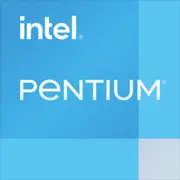Intel Pentium G4620

Intel Pentium G4620: A Budget Processor for Basic Tasks in 2025
Introduction
Even years after its release, the Intel Pentium G4620 remains a popular choice for budget PCs. This dual-core processor based on the Kaby Lake architecture (2017) remains relevant due to its low power consumption and support for Hyper-Threading. In this article, we will discuss who the CPU is suitable for in 2025, how to build a system based on it, and what pitfalls to consider.
1. Key Specifications
Architecture and Process Technology
The Pentium G4620 is built on a 14nm process technology and belongs to the Kaby Lake generation, the last Intel family before the transition to hybrid cores (followed by Coffee Lake).
- Cores and Threads: 2 cores / 4 threads thanks to Hyper-Threading.
- Frequency: Fixed base frequency of 3.7 GHz (no turbo mode).
- Cache: L3 — 3 MB, L2 — 512 KB per core.
- TDP: 51W — can be easily cooled even with passive coolers.
Performance
Based on Geekbench 6 tests (2025):
- Single-threaded: 736 points — equivalent to Intel Core i5-7400.
- Multi-threaded: 1603 points — weaker than Ryzen 3 1200 (4 cores / ~2000 points).
Key Features:
- Support for Intel Virtualization for virtualization tasks.
- Integrated Intel HD Graphics 630 (basic video processing, no 4K 60 FPS).
- Compatibility with Windows 10/11 and Linux.
2. Compatible Motherboards
Socket and Chipsets
- Socket: LGA 1151 (version v2, not compatible with Coffee Lake motherboards!).
- Chipsets: H110, B250, H270, Z270.
Examples of Motherboards:
- ASUS Prime B250M-A (about $60-80 on the secondhand market in 2025).
- Gigabyte GA-H110M-S2H (from $40) — requires a BIOS update for Kaby Lake support.
Selection Features:
- Ensure that the motherboard’s BIOS is updated to the version supporting Kaby Lake.
- For overclocking (if available), a Z270 chipset is needed, but the G4620 does not support overclocking.
3. Supported Memory
- Types: DDR4-2400 (officially), DDR3L-1600 (on some boards).
- Maximum Capacity: Depends on the motherboard — typically up to 64 GB (but excessive for the G4620).
Recommendations:
- The optimal option is 8-16 GB DDR4-2400 (e.g., Kingston HyperX Fury, $25-50 for an 8 GB module).
- DDR5 and PCIe 4.0/5.0 not supported — this is a limitation of the platform.
4. Power Supply Recommendations
With a TDP of 51W, the processor has a modest impact on overall power consumption.
- Without a discrete graphics card: A power supply of 300-400W (Corsair CV450 — $45).
- With a graphics card (e.g., GTX 1650): A power supply of 450-500W (EVGA 500 BR — $55).
Important:
- Don’t skimp on the power supply! Cheap models (like Apevia) can damage components.
- For passive cooling, look for power supplies with a Zero RPM mode (e.g., be quiet! Pure Power 11 400W).
5. Pros and Cons
Pros:
- Price: New units (rare in 2025) — $50-70, used — $20-30.
- Energy Efficiency: Ideal for low-power builds (home servers, office PCs).
- Hyper-Threading: Better multi-threading vs. dual-core processors without HT (such as Pentium G4560).
Cons:
- 2 Cores: Modern games (Cyberpunk 2077, Starfield) require 4+ cores.
- Outdated Platform: No upgrade path to newer CPUs without changing the motherboard.
- Weak Graphics: HD 630 will not handle even Fortnite on low settings.
6. Use Scenarios
Office and Web Browsing
- Working with documents, browser (+20 tabs), Zoom conferences.
- Example: A PC based on G4620 + 8 GB DDR4 + 256 GB SSD — $150-200.
Multimedia
- Watching 1080p videos, streaming via Plex.
- For 4K HDR, an external graphics card is required (e.g., GT 1030).
Light Gaming
- Older titles: CS:GO, Dota 2 (60 FPS on low settings).
- Emulators: PlayStation 2, GameCube — handles them at medium settings.
7. Comparison with Competitors
AMD Athlon 3000G (2025 Price: $60-80)
- 2 cores / 4 threads, Vega 3 (graphics stronger than HD 630).
- Cons: Lower frequency (3.5 GHz), AM4 platform requires replacement for upgrade.
Intel Pentium Gold G5600
- 2 cores / 4 threads, 3.9 GHz, UHD Graphics 630.
- Price: $70-90. The performance difference with G4620 is up to 10%.
Recommendation:
If graphics are needed — go for the Athlon 3000G. For tasks requiring IPC (single-threaded performance) — choose the G4620.
8. Practical Assembly Tips
1. SSD is essential: Kingston A400 240GB ($30) will eliminate bottlenecks in everyday tasks.
2. Cooling: The stock cooler is sufficient, but for quiet operation, consider the Deepcool GAMMAXX 400 ($20).
3. Motherboard: Look for models with M.2 and USB 3.1 (e.g., ASRock B250M Pro4).
4. Upgrade: The best addition would be a GTX 1660-level graphics card (but the processor will become the bottleneck).
9. Final Verdict: Who is the Pentium G4620 Suitable For?
This processor is a good choice if:
- Budget is limited, and tasks are simple: office work, studying, HTPC.
- You need a quiet system (you can build a PC without fans).
- You plan to use old components (DDR4, motherboards from 2017-2019).
Alternative for 2025: If the budget allows $100-150, consider a used Intel Core i3-9100 (4 cores) or Ryzen 3 3100.
The Pentium G4620 is not for gamers or video editors, but as a "workhorse" for basic tasks, it is still relevant. The key is to understand its limitations clearly.
Basic
CPU Specifications
Memory Specifications
GPU Specifications
Miscellaneous
Benchmarks
Compared to Other CPU
Share in social media
Or Link To Us
<a href="https://cputronic.com/cpu/intel-pentium-g4620" target="_blank">Intel Pentium G4620</a>